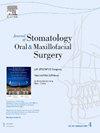Virtual surgical planning in orthognathic surgery: A prospective evaluation of postoperative accuracy
IF 1.8
3区 医学
Q2 DENTISTRY, ORAL SURGERY & MEDICINE
Journal of Stomatology Oral and Maxillofacial Surgery
Pub Date : 2025-02-01
DOI:10.1016/j.jormas.2024.102025
引用次数: 0
Abstract
Objectives
The development of 3D computer-assisted technologies over the past years has led to vast improvements in orthognathic surgery. The aim of the present study was to evaluate differences in maxillary position between 3D virtual surgical planning (VSP) and surgical results.
Materials and methods
We assessed data from 25 patients who underwent bimaxillary non-segmented orthognathic surgery with 3D VSP. Each patient underwent a postoperative CT scan within 40 days after surgery. We compared the STL (Standard Triangulation Language) file from the VSP with that obtained from the postoperative CT.
Results
According to our comparative analysis, the postoperative and VSP 3D models did not statistically differ. The Lin concordance correlation coefficient was always >0.95 for each landmark, but in 21 patients (84 % of the sample) we identified at least one point with a difference of more than 1.5 mm between the postoperative and VSP 3D model on at least one axis. The most frequently observed differences corresponded to sagittal translation and pitch rotation.
Conclusions
An intraoperative clinical and aesthetic evaluation of the consequences of bone movements on patient face is strongly recommended, also when we use VSP because we may have clinically significant differences from the planning.
正颌外科手术中的虚拟手术规划:术后准确性的前瞻性评估。
目的:过去几年中,三维计算机辅助技术的发展极大地改进了正颌外科手术。本研究旨在评估三维虚拟手术规划(VSP)与手术结果之间在上颌骨位置上的差异:我们评估了使用三维虚拟手术规划进行双颌非分段正颌手术的 25 名患者的数据。每位患者都在术后 40 天内接受了术后 CT 扫描。我们将 VSP 的 STL(标准三角测量语言)文件与术后 CT 的文件进行了比较:根据我们的比较分析,术后模型和 VSP 3D 模型在统计学上没有差异。每个地标的 Lin 一致性相关系数始终大于 0.95,但在 21 名患者(占样本的 84%)中,我们发现术后三维模型和 VSP 三维模型至少在一个轴上有一个点的差异超过 1.5 毫米。最常见的差异是矢状位移和俯仰旋转:强烈建议在术中对骨移动对患者面部造成的后果进行临床和美学评估,在使用 VSP 时也是如此,因为我们可能会在临床上发现与规划存在显著差异。
本文章由计算机程序翻译,如有差异,请以英文原文为准。
求助全文
约1分钟内获得全文
求助全文
来源期刊

Journal of Stomatology Oral and Maxillofacial Surgery
Surgery, Dentistry, Oral Surgery and Medicine, Otorhinolaryngology and Facial Plastic Surgery
CiteScore
2.30
自引率
9.10%
发文量
0
审稿时长
23 days
 求助内容:
求助内容: 应助结果提醒方式:
应助结果提醒方式:


